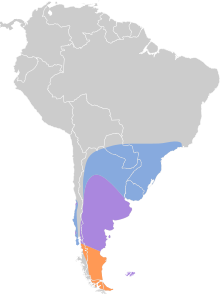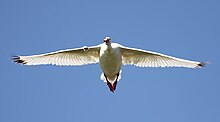Coscoroba swan
| Coscoroba swan | |
|---|---|

| |
| Scientific classification | |
| Kingdom: | Animalia |
| Phylum: | Chordata |
| Class: | Aves |
| Order: | Anseriformes |
| Family: | Anatidae |
| Genus: | Coscoroba Reichenbach, 1853 |
| Species: | C. coscoroba
|
| Binomial name | |
| Coscoroba coscoroba (Molina, 1782)
| |

| |
The coscoroba swan (Coscoroba coscoroba) is a species of waterfowl endemic to southern South America. It is the smallest of the birds called “swans”, but still a large species of waterfowl. It belongs to the subfamily Anserinae in the family of ducks, swans, and geese, Anatidae. It is placed in the monotypic genus Coscoroba. The coscoroba swan is traditionally considered as an early branch from the common ancestor leading to true geese and swans, and recent genetic studies have associated a phylogenetic relationship between this species and the Cape Barren goose (Cereopsis novaehollandiae) as sister groups.[2]
Description[]

Male coscoroba swans weigh 3.8–5.4 kg (8.4–11.9 lb) and females weigh 3.2–4.5 kg (7.1–9.9 lb). The length is from 87.5 to 115 cm (34.4 to 45.3 in) and the wingspan is 155 to 160 cm (61 to 63 in).[3] They have white plumage except for black tips to the outer six primary feathers, although this black is often barely visible on the closed wing. In flight, the black wing tips are conspicuous. The bird has a red beak, legs and feet. They look somewhat more like geese than swans. The female looks almost identical to the male. The cygnet is a patchy color, with brown and gray hues. The coscoroba swan lacks the patch of bare skin between the eyes and beak typical of swans. They look like a very small swan in body and look like a goose in the head. Eggs measure 89 X 61 mm, with averages of 82 to 94 53 to 67 mm, with an average weight of 170 grams and range from 129 to 203 grams
Distribution and habitat[]
The coscoroba swan breeds in South America from southern Chile and central Argentina south to Tierra del Fuego and the Falkland Islands. In winter it flies north to central Chile, northern Argentina, Bolivia, Uruguay and the southeast tip of Brazil. Its habitat is well-vegetated swamps and lagoons. Its population is estimated at 10,000–25,000 birds.[1][4] It also has an ancient route to the Pantanal of Brazil and has been seen in large flocks in the Nhecolandia and Rio Negro regions.
Coscoroba swans have escaped or been deliberately released in to Florida, USA, but there is no evidence that the population is breeding and may only persist due to continuing releases or escapes.[1]
Behavior[]
The coscoroba swan feeds on various plant matter, small aquatic insects, and small fish. The female incubates the eggs, while the male stands guard and aggressively helps to protect the fledglings against predators after hatching. Coscoroba swans live to an age of approximately twenty years.
Gallery[]

Juveniles in Rio Grande do Sul, Brazil

Bath taking at Weltvogelpark Walsrode

Swimming

At Berlin Zoo, Germany
References[]
- ^ a b BirdLife International (2016). "Coscoroba coscoroba". IUCN Red List of Threatened Species. 2016: e.T22679866A92832574. doi:10.2305/IUCN.UK.2016-3.RLTS.T22679866A92832574.en. Retrieved 13 November 2021.
- ^ Rodrigues, B.S. et al. (2014) Chromosomal studies on Coscoroba coscoroba (Aves: Anseriformes) reinforce the Coscoroba–Cereopsis clade. Biological Journal of the Linnean Society, 111: 274–279.
- ^ del Hoyo, J. Elliott, A. & Sargatal, J. (1992) Handbook of the Birds of the World. Volume 1: Ostrich to Ducks. Lynx Edicions. ISBN 84-87334-10-5.
- ^ BirdLife International (2010). "Species factsheet: Coscoroba coscoroba". Retrieved 3 August 2010.
External links[]
 Media related to Coscoroba coscoroba at Wikimedia Commons
Media related to Coscoroba coscoroba at Wikimedia Commons
- IUCN Red List least concern species
- Swans
- Anserinae
- Birds of Argentina
- Birds of the Falkland Islands
- Birds described in 1782




